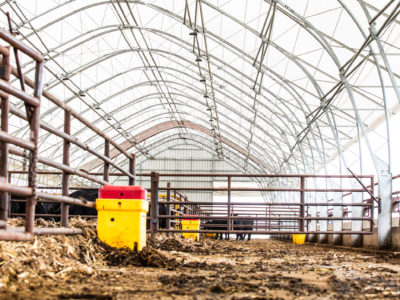Iowa NRCS Issues New Standard for Conservation Practices
10-31-2013 in Cattle
By: Dirck Steimel, Iowa Farm Bureau Spokesman
Reprinted with permission of the Iowa Farm Bureau Spokesman
The Iowa office of the U.S. Department of Agriculture’s Natural Resources Conservation Service (NRCS) last week rolled out a new standard for implementing that nutrient management plans that are typically required for participation in federal conservation costshare programs, such as the Environmental Quality Incentives Program (EQIP) or Conservation Stewardship Program (CSP).
The updated standard, called the 590 Standard, treat commercial fertilizer and manure more similarly than in the previous plan. The new NRCS standard calls for delaying fall manure applications until soil temperatures are 50 degrees and trending lower. That is the standard is the same for fall applications of commercial MAP and DAP fertilizer.
The standard also adds tile intakes to sensitive areas that should be protected with filter strips or other practices for water quality; allows for emergency applications of nitrogen when heavy spring rains cause a significant loss in soil nutrients; and includes the use of cover crops, filter strips and other practices to control nutrient loss.
The NRCS 590 standard is updated every five years, with the last revision in 2008. The updated standard, developed over the past year after the agency gathered input from farmers, agronomists and others, is designed to balance the needs of agriculture and the environment, said Eric Hurley, the nutrient management specialist with the Iowa NRCS. “The practice standard helps farmers plan nutrients for optimal crop production and fully utilize manure or organic by products at nutrient sources,” Hurley said. “It also protects water quality by minimizing agricultural nonpoint source pollution and helps improve soil health.” Hurley said that standard will be used for any new nutrient management plans written by NRCS or crop consultants in Iowa for federal or state cost-share programs. Farmers with existing NRCS nutrient plans will be given option to stay with the old 590 standard or move to the new one, he said.
The revised NRCS standard is an important step forward as farmers begin to implement the voluntary Iowa Nutrient Reduction Strategy, said Rick Robinson, the Iowa Farm Bureau Federation environmental policy advisor. The state nutrient reduction strategy provides farmers information on a menu of options, such as cover crops, bioreactors or wetland installations, which have proven to reduce nutrient loss from fields.
“It’s very important that the NRCS standard are aligned with the entire nutrient management conservation planning process for farmers,” Robinson said. “Iowa farmers are committed to caring for our land and water resources, while they work to produce the food and fuel the world needs. It’s important that state and federal nutrient reduction programs are closely aligned to help farmers accomplish those goals.”
A key element of NRCS standards, especially with provisions on the timing of fall manure applications, will be the flexibility that the agency uses as it implements them, Robinson said. “There are often cases, because of the weather or other factors, when farmers may need to apply manure when the temperature is not exactly within the NRCS standard,” he said. “And frankly, there was less farmer input during this revision process than there was the last time, so some are just learning of these changes. The science will need to be balanced with common sense during implementation. It appears that is the intent.”
The NRCS standard does point out that that “actual application timing may occasionally vary due to fall weather, the weather forecast, soil conditions, including vulnerability to compaction, and logistics,” Hurley noted. Farmers with a nutrient management plan would then make a judgment call if the 50-degrees provision is not workable and then self-certify why the actions were taken, he said.
“We know that the window for applying manure can be short in the fall and we want to build in flexibility,” Hurley said.
One provision in the revised standard that should appeal to farmers is the one for “rescue” nitrogen applications, Hurley said. The provision allows farmers to apply additional nitrogen to save the crops in year that heavy rains cause a significant loss in nitrogen like 2013, he said.
“Even with good management, farmers can lose nitrogen when excessively heavy rains hit their fields,” Hurley said. “Many of Iowa’s field agronomists requested that this provision be included in the standard, for good reason.”
Go to www.ia.nrcs.usda.gov for all of the new NRSC nutrient management standard.
Recommended News

Robbins Family Hosts Cattle Building Open House
Farmers interested in learning about the benefits of raising cattle under roof are invited to attend an open house at the Robbins family farm to tour Justin and Lacie Robbins...
Read More
Farming is a Family Affair
The Streit family of West Bend, Iowa, has cultivated their farm for over three decades, fostering a legacy of hard work and community support. Diane and Tony Streit, alongside their...
Read More
CSIF to Host Calving Under Roof Open House
WEST DES MOINES, IOWA – June 10, 2022 – The Coalition to Support Iowa’s Farmers (CSIF) is hosting a “Calving Under Roof Open House” at the Laura and Aaron Cunningham farm...
Read More